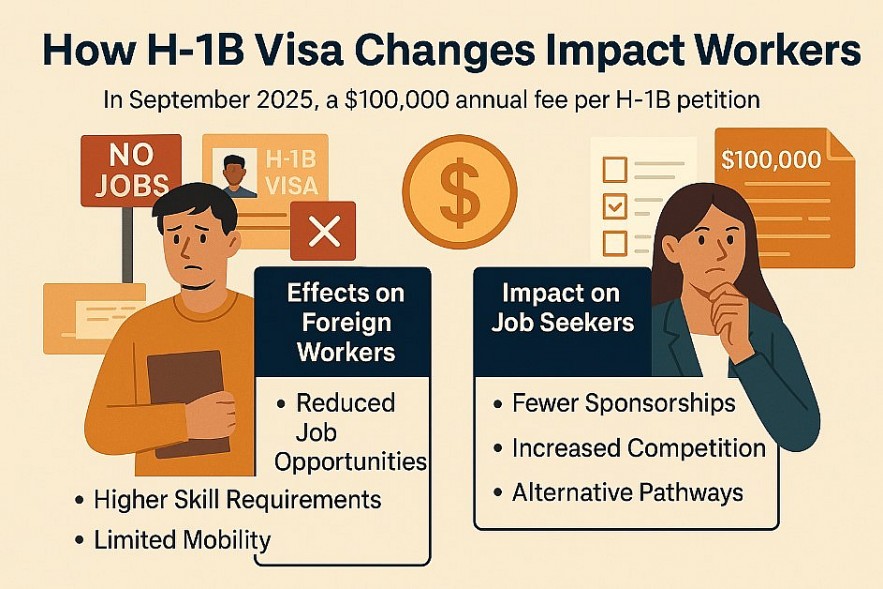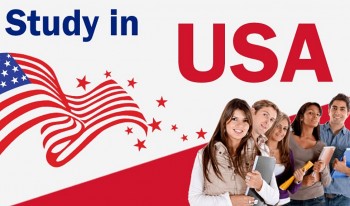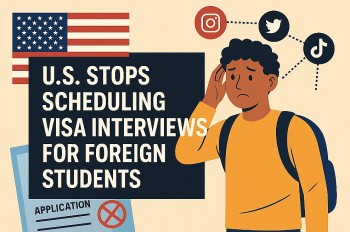How H‑1B Visa Changes Impact Workers in 2025/2026
In 2025, the U.S. government introduced a sweeping overhaul of the H‑1B visa program—a program that, for decades, served as the backbone of foreign skilled labor in the American workforce.
At the center of this reform is a $100,000 annual fee imposed on every H‑1B visa petition submitted by U.S. employers. While the policy targets employers directly, its ripple effects are being felt just as powerfully by foreign workers, U.S. employees, and companies across the nation.
This article explores how the new H‑1B visa rules are changing the landscape for workers and what it means for the future of skilled labor in the United States.
Read more: H‑1B Visa $100,000 Fee: What It Means, Who’s Affected, and Why It Matters
 |
| How H‑1B Visa Changes Impact Workers |
What Is the H‑1B Visa and Why Does It Matter?
The H‑1B visa is a nonimmigrant work visa that allows U.S. companies to hire foreign professionals in specialty occupations—typically in tech, engineering, finance, healthcare, and academia. Each year, over 85,000 new H‑1Bs are granted through a lottery system, with hundreds of thousands of applicants competing for limited spots.
It’s long been a critical talent pipeline for employers—and a primary pathway to long-term employment and green cards for foreign professionals.
What Changed in 2025?
In September 2025, the White House issued an executive order mandating that all H‑1B petitions must now include a $100,000 annual fee per worker. This cost is in addition to existing visa and legal processing fees.
The administration’s stated goals:
-
Deter companies from hiring lower-paid foreign labor
-
Encourage use of the program for only “exceptionally skilled” or “highly paid” workers
-
Protect domestic workers and boost U.S. wages
But behind the political rhetoric, the real-world effects are complex—and in many cases, unintended.
How the H‑1B Fee Affects Foreign Workers
1. Fewer Job Offers and Sponsorships
Many companies—especially small to mid-sized firms—are now backing away from H‑1B sponsorship altogether. The added cost of $100,000 per year per employee has made it economically impractical to sponsor junior or mid-level roles. As a result:
-
Qualified foreign workers are seeing fewer job offers
-
More international job seekers are turned away despite strong credentials
-
Entry-level roles are increasingly closed to non-citizens
2. Career Pathways Are Narrowing
Previously, workers on OPT (Optional Practical Training) or L-1 visas could transition into H‑1B status as part of a long-term employment strategy. With the new cost barrier, many employers no longer offer this pathway—leaving workers stranded in temporary or expiring visa statuses.
For many, this change cuts off a vital step toward permanent residency and long-term career growth in the U.S.
3. Higher Pressure to Justify Their Value
Those who are sponsored must now meet a much higher bar. Employers expect H‑1B employees to justify the six-figure sponsorship cost by delivering outsized value from day one.
This puts immense pressure on foreign workers to:
-
Earn above-market salaries
-
Possess rare, high-demand skills (e.g., AI, machine learning, quantum computing)
-
Outperform peers to retain their visa status
For some, it creates a high-stress, high-stakes work environment that’s unsustainable.
Impact on U.S. Workers
While the policy is designed to protect American workers, the effects are not universally positive.
1. Potential Rise in Wages (But With Fewer Jobs)
Some U.S. workers in tech and engineering may see wage increases as companies reduce reliance on H‑1B workers and compete for domestic talent. However, others may lose out entirely if companies:
-
Scale back hiring due to limited talent supply
-
Move jobs offshore to avoid the H‑1B fee
-
Automate functions previously handled by skilled human labor
2. Loss of Global Talent and Innovation
Many foreign professionals contribute directly to innovation, patents, and startup creation. When access to this talent is restricted, the U.S. risks losing its competitive edge in fields like biotechnology, cloud computing, and advanced manufacturing.
Read more: How H‑1B Visa Changes Impact International Students in 2025/2026
Industry Response: Who’s Affected Most?
Tech Sector
Big Tech firms like Google and Microsoft may absorb the cost, but even they are expected to cut back on the number of H‑1B sponsorships, focusing only on critical, high-impact hires.
Startups and mid-sized tech firms face more severe disruption. Many rely on H‑1B talent to fill niche roles that U.S. talent pipelines can’t meet fast enough.
Healthcare and Academia
Hospitals and universities—long reliant on H‑1B professionals for research, medical residency, and specialty care—are pushing back, calling for exemptions. Without relief, rural and underserved areas may suffer from acute labor shortages in essential fields.
Long-Term Consequences
-
Reduced International Recruitment
U.S. companies may shift operations or hiring abroad, especially in Canada, Europe, or India—where talent is more accessible. -
Brain Drain Reversal
Talented foreign professionals who would have stayed and built careers in the U.S. are now looking to friendlier immigration systems elsewhere. -
Talent Flight from the U.S. Education System
International students, seeing reduced job opportunities post-graduation, may skip U.S. universities altogether in favor of countries offering clearer post-study work options.
What Can Foreign Workers Do?
Despite the barriers, there are strategies foreign workers can adopt:
-
Focus on niche expertise: Skills in AI, cybersecurity, blockchain, and biotech remain in high demand.
-
Explore alternative visas: O‑1 (extraordinary ability), L‑1 (intra-company transfer), or employer-sponsored green cards.
-
Look globally: Consider building a career in Canada, the UK, or Australia, with the possibility of returning to the U.S. later.
-
Build employer trust early: Start conversations about sponsorship early in the interview process, and demonstrate clear ROI.
Frequently Asked Questions (FAQs) for Job Seekers
1. Who is responsible for paying the $100,000 H‑1B visa fee?
Only U.S. employers are responsible for the fee. It is illegal for companies to pass this cost to foreign workers directly or indirectly.
2. Can I still get an H‑1B visa for an entry-level role?
It’s now extremely difficult. Most companies will only sponsor senior or high-impact roles that justify the $100,000 cost.
3. Is the $100,000 fee permanent?
As of now, yes. However, the policy could change depending on legal challenges, administrative shifts, or future elections.
4. What other visa options do I have besides H‑1B?
Alternatives include the O‑1 visa (for extraordinary ability), L‑1 visa (intra-company transfer), and TN visa (for Canadian and Mexican citizens).
5. Does this change affect my chances as a recent graduate on OPT?
Yes. Many employers are now hesitant to convert OPT employees to H‑1B status unless they hold rare skills or generate high ROI.
6. What can I do to improve my chances?
Focus on in-demand, specialized skills; gain practical experience through internships; apply early; and consider global opportunities outside the U.S.
Final Thoughts
The new H‑1B visa fee marks a major turning point in U.S. immigration and labor policy. While designed to protect American jobs, it creates new challenges for foreign workers, employers, and the future of innovation in the U.S.
For foreign professionals, success in this new environment means being highly skilled, highly strategic, and globally mobile. For employers, it means rethinking how and where to invest in talent. For the country, it means balancing national interest with global competitiveness.
 What Are the New U.S. Visa Interview Rules in 2025? Don’t Miss These Visa Changes What Are the New U.S. Visa Interview Rules in 2025? Don’t Miss These Visa Changes Planning a trip to the United States after April 2025? You’ll want to pay close attention. |
 Fact Check: New U.S. Policy on Terminating International Students’ Legal Status Fact Check: New U.S. Policy on Terminating International Students’ Legal Status In early 2025, a U.S. government policy targeting thousands of international students shocked the higher education community. |
 U.S. Halts Student Visa Interviews: What This Means and How to Prepare U.S. Halts Student Visa Interviews: What This Means and How to Prepare The U.S. has suspended new student visa interviews to expand social media vetting. This update affects thousands of international applicants. Learn what it means, who’s ... |
 How Many Chinese Students Are in the U.S.? Latest Numbers, Visa Crackdowns, and What’s Next How Many Chinese Students Are in the U.S.? Latest Numbers, Visa Crackdowns, and What’s Next Chinese students have long been a significant presence in American universities, contributing to academic excellence and cultural diversity. |

























